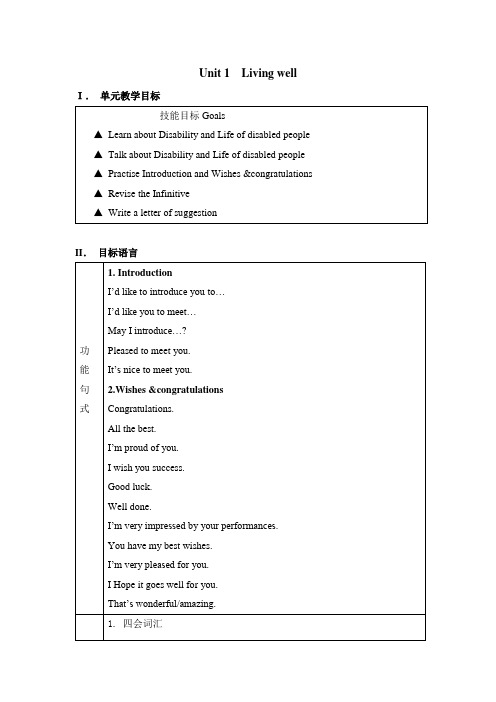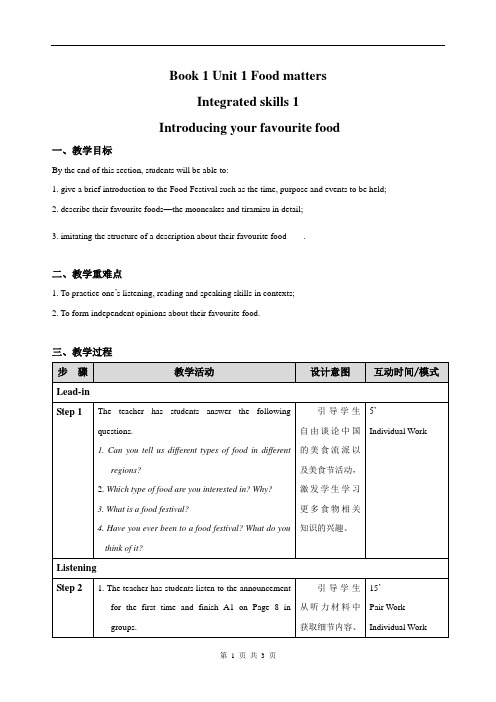最新新技能英语 高级教程1 教学设计unit 1教学文稿
- 格式:doc
- 大小:90.00 KB
- 文档页数:10


人教版高中英语必修一unit1教案最终版(word版可编辑修改)编辑整理:尊敬的读者朋友们:这里是精品文档编辑中心,本文档内容是由我和我的同事精心编辑整理后发布的,发布之前我们对文中内是任然希望(人教版高中英语必修一unit1教案最终版(word版可编辑修改))的内容能够给您的工作和学反馈,这将是我们进步的源泉,前进的动力。
本文可编辑可修改,如果觉得对您有帮助请收藏以便随时查阅,最后祝您生活愉快业绩进步,以下为人教编辑修改)的全部内容。
Teaching Plan Unit1 Friendship 教材人教版高中英语必修一试讲者李瑶单位适用年级高中一年级单元课题Anne’s Best Friend课时共( Reading)一.教材分析 Analysis of the Teaching MaterialsThis unit is the first unit of the senior English stud friendship。
As for the students, at the beginning of s making new friends is one of important things for them this unit is appropriate at the present time. It can e students’interests in English learning and help stude choose friends and the meaning of the friendship。
The the center of the unit。
It mainly talks about the Ann during the world war II, regarded the diary as her be her happiness, sorrow and missing to her hometown。

Unit 1 Living well I.单元教学目标II.目标语言IV.重点词汇(旨在提供综合运用所需材料)1. ambition (n.) 雄心[重点用法]ambitious adj. 志向远大的; 有雄心壮志的;有野心的be ambitious for [power, social position, etc.] 极欲获得[权力, 社会地位等]be ambitious of success渴望成功be ambitious to serve the people一心想为人民服务[典例]1) Her ambition is the presidency. 她的抱负是成为一名总统2) After several hours’ work, she had no ambition to go dancing.没有精力去跳舞了3) The prince was attracted by the girl’s beauty, and ambitious to marry her.王子为女孩的美貌打动了,渴望能娶到她。
2. beneficial (adj.) 有益的[重点用法]benefit v. &n.有助于;受益;利益,好处be beneficial to sth./sb.对……有益be of benefit to对……有益for the benefit of为了……(的利益)benefit from从……中受益[典例]1) A temperate climate is beneficial to the health; 温和气候有利于健康.2) Sunshine is beneficial to plants. 阳光对植物有益。
3) I hope what I have written will be of benefit to someone else who may feel the same way. 我希望我写的这些将对有同感的人有帮助.4) Both sides have benefited from the talks.双方都从和谈中受益。

● Word PowerStep 1: BrainstormingT: Have you heard of Shakespeare? Can you say out some of his works?S: “Romeo and Julie”, “Merchants of Venice” and so on.T: Have you seen them performed on the stage?S: Yes. /No.T: A piece of writing to be performed by actors in the theatre is called drama. Are you interested in drama? Do you want to learn something more about drama? Today we’ll learn some words used in a drama on the stage.Step 2: Brainstorming and vocabulary learning1 First, let’s check how muc h you have known about drama.T: What do we call the person who acts in a play?S: An actor or actress.T: What do we call the person who is in charge of a play?S: A director.T: what are the words that the actors say called?S: linesT: Where can the lines can be found?S: In a script.T: what is a script made up of?S: Acts and scene.T: What are the words called that tell the actors how to act?S: They are called stage directions.Write these on the blackboard and make sure the students know the meaning of each word.2 After you have grasped the above words, let’s focus on the picture in part B, whichgives you some information related to things on a stage.3 Let’s focus on the passage in part C, which checks yours’ ability of understanding and using the words you have just learnt. In order to fill in the blanks correctly, you have to understand the passage and the exact meaning of the missing words. You should first plete the exercises individually and then check answers with the class. Answers1 actor2 director3 lines4 cast5 script6 stage7 acts 8 scenes 9 costume 10 wings 11 props 12 light13 scenery 14 stage directionsStep 3: Vocabulary extension1Boys and gi rls, let’s suppose you are going to perform a drama at the school art festival. Discuss in your group: How you are going to prepare and arrange for the performance. The following words can help you.A dramacast directors, actors, actressesscript theme, lines, stage direction,acts/scenesstage wings, microphone, curtains, lights,scenery, setothers Budge, props, costumes2 Let’s e to part D. We know in English, there are many useful idioms and saying about laughing and it is good for us to keep some useful idioms in mind. This part will present some to us. Look at the idioms and the sentences below. Then see if you can find any more idioms about smiling or laughing and write sentences using them in the space provided.Sample answersto have the last laugh: to make someone who has criticized or defeatedyou look stupid by succeeding in something more important or by seeingthem faile.g. They fired her last year, but she had the last laugh because she was taken on by their main rivals at twice the salary.He laughs best who laughs last.all smiles: being happy again especially after feeling sade.g. When Mary found out about the holiday, she was all smiles.Step 4: Consolidation exercises.1 Write out the words according to the English explanations.1 make somebody laugh or simile ____________2 the person in charge of a play ____________3 very good of high quality ____________4 full of eagerness or interest ____________5 perform without preparation ____________6 take place, happen ____________7 worried or afraid ____________8 unlike anything else ____________9 text of a play, film, ____________10 instrument that changes sound waves into electrical current used in broadcastingspeech, music, etc. _____________II. ReadingWords: 333;time: 5’30”A night of funWednesday night 7:30 p.m. at the Chuckle Bar!Starring Rodney Mann, Pedro Mendez and Larry Dunne!Next Wednesday night at the Chuckle Bar we have an all-star line-up of edians. Three of the wor ld’s best known edians are ing together for one night only. Book your tickets by calling 1-900-555-6565 or be at the door early to buy them before the show begins.Rodney MannMann is famous for his jokes about average people and their lives. Many of his jokes are social mentaries on everyday. He loves to set his jokes in New York, the city where he grew up.Mann’s most famous opening line, “You know, I was walking down the street the other day…’ is know all over the world. He is just back from his tour of Europe, and is appearing at the Chuckle Bar for one night only. Don’t miss out!Pedro MendezPedro Mendez grew up on a small farm in Panama. He moved to the USA with his parents when he was ten, and has been telling jokes and making people laugh ever since. Recently, the 30-year-old edian began filming a new TV programmer that he will both act in and produce.Experience Mendez’s unique Latin style humor for yourself. His “I had a farm in Panama” routine is a classic that should not be missed.Larry DunneLarry Dunne has been making people laugh all over the world for more than five decades. He began his career by performing for soldiers in Hawaii in the 1950s, and since then, he has been the host of his own late night TV programmer. The videos and DVDs of his performances are the best selling of any stand-up act out there. An old style edian, Dunne uses lots of singing and dancing as part of his routines.Dunne is best known for his jokes about life in the USA and how it has changed during his lifetime. This will be Dunne’s last show before he retires, so don’t miss it.Call 1-900-555-6565 to reserve your tickets or be at the door by 7:00 p.m.1 The edy show will have_______ edians on _______ night.A three; oneB three; twoC one; threeD one; two2 Rodney Mann grew up in ________.A the USAB PanamaC HawaiiD New York3 The show begins _______.A at lunch timeB at 7:30 p.m.C at 7:00 p.m.D at 7:30a.m.4 Pedro Mendez has lived in ______for _____ years.A the USA; thirty-fourB the USA; tenC Panama; thirty-fourD the USA; twenty5 The oldest edian is probably ________, and has been performing _______.A Rodney Mann; for over fifty yearsB Larry Dunne; since the 1970sC Larry Dunne; for over fifty yearsD Pedro Mendes; for over fifty yearsStep 5: Homework1 Parts B1 and B2 on page101 of the Workbook.2 Prepare the Part Grammar and Usage。


Book 1 Unit 1 Food mattersIntegrated skills 1Introducing your favourite food一、教学目标By the end of this section, students will be able to:1. give a brief introduction to the Food Festival such as the time, purpose and events to be held;2. describe their favourite foods—the mooncakes and tiramisu in detail;3. imitating the structure of a description about their favourite food.二、教学重难点1. To practice one’s listening, reading and speaking skills in contexts;2. To form independent opinions about their favourite food.三、教学过程步骤教学活动设计意图互动时间/模式Lead-inStep 1 The teacher has students answer the following questions.1. Can you tell us different types of food in differentregions?2. Which type of food are you interested in? Why?3. What is a food festival?4. Have you ever been to a food festival? What do youthink of it?引导学生自由谈论中国的美食流派以及美食节活动,激发学生学习更多食物相关知识的兴趣。
Book 3 Module 4 Planes, ships and trains一、教学内容:Unit1 He lives the farthest from school.二、课型:Listening and speaking三、教学目标:1、能正确运用词汇:road, accident, except, far, far away, crowded, choice, classmate, all the time, journey, book, outside, close, park, however, cost2、能听懂含有形容词、副词最高级形式的对话及旅行方式和交通工具的描述。
3、能够使用形容词、副词最高级形式谈论并比较旅行方式和交通工具。
四教学重难点:能够使用形容词、副词最高级形式谈论并比较旅行方式和交通工具。
五教学准备:本课指导学生通过听力获取信息,培养学生听力技能。
课堂上采用多媒体手段辅助教学,多媒体课件。
六预习要求:根据音标自学本课新单词。
七教学过程:达标训练题A. 随学随练:写出下列单词的最高级形式:1. short _________________2. nice _________________3. big _________________4. thin _________________5. early _________________6. slowly _________________7. beautiful _________________8. carefully _________________9. badly _________________ 10. much _________________11. little _________________ 12. far __________________B. 单项选择:( ) 1. Debbie is growing fast. She is even________ than her mother.A. tallB. tallerC. tallestD. the tallest ( )2.—Dad, would you please drive ________?— No hurry. We have enough time before the plane takes off.A. fasterB. more slowlyC. more carefully( ) 3.—Do you know Lin Shuhao?—Yes. He is one of _____ basketball players in the NBA.A. popularB. more popularC. the most popular ( ) 4. Is Lily’s home _____ away from school than Linda’s?A. farB. fartherC. farthest .( ) 5.—Who ran ______ of all in the sports meeting?—Hector did, I think.A. fastB. fasterC. the fastestD. most fast ( ) 6. Li Na is ________ tennis player in China now.A. most famousB. the most famousC. more famous11。